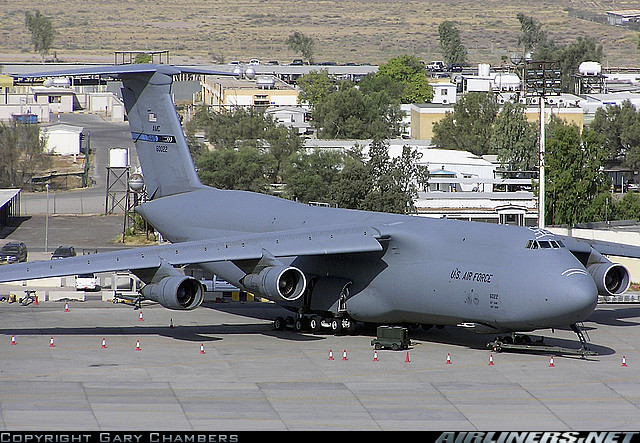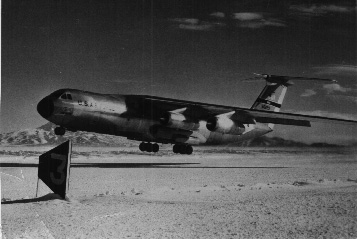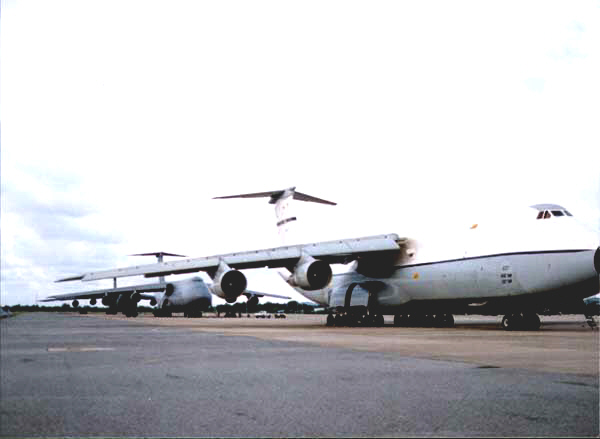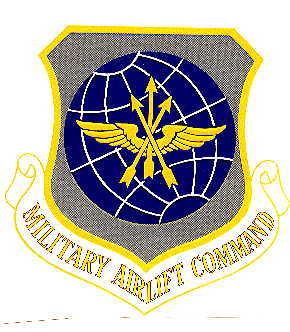

When World War II ended, the future of the long-range airlift mission was very much in doubt. While the Air Transport Command had performed yeoman's service in the latter years of the war, it was looked upon by many within the military and out as an airline in olive drab. Although the Troop Carrier Command had proven itself as a valuable combat asset, ATC had functioned purely in a behind-the-scenes role delivering cargo and aircraft from the United States to overseas destinations. Even the famous "Hump Airlift" had been a logistical mission, though some ATC airplanes and crews were occasionally detached to the Troop Carrier Command for combat duty. As the war drew to a close, the leadership of ATC began lobbying for a post-war role. They were opposed both by Troop Carrier Command officers, who felt that the troop carrier forces should be beefed up with more capable aircraft, and leaders in the civilian aviation industry, many of whom had served in uniform with ATC, who felt that the ATC mission could best be served by the civilian airlines through military contracts. Some national leaders felt that ATC should be expanded to become a national airline. Major controversy erupted over the status of ATC, controversy that would continue through the 1950s.
In 1947 the United States Air Force came into being as part of the new Department of Defense which was established to replace the War and Navy Departments. In December of that year the Secretaries of the Air Force and Navy began discussions with Secretary of Defense James Forrestal regarding the consolidation of ATC and the Navy's Naval Air Transport Service. The outcome of the discussions was the creation of an Armed Forces Air Transport Service under the new USAF. The Navy was allowed to maintain its own internal administration airlift, with the stipulation that it be unscheduled. As the new service developed, Naval personnel became part of the new organization, which was renamed Military Air Transport Service prior to it's official establishment on June 1, 1948. The MATS staff inserted "deployment of troops" in the new service's mission statement and the Air Force staff either overlooked it or let it stand. In spite of it's title, MATS did not include all military airlift, nor would it. While MATS was responsible for meeting the air transportation needs of the Department of Defense and it's agencies, the role of supporting combat troops remained with the Troop Carrier Command, which fell under the Tactical Air Command and the overseas commands in later reorganizations. The troop carrier, or tactical or combat airlift, mission remained separate from MATS and it's descendant, the Military Airlift Command, until 1975 and the end of the Vietnam War. MATS remained a logistical organization, with no combat role.
MATS came into being in the middle of an emerging conflict over the divided city of Berlin. Within a few days of the activation of MATS, the Soviets and East Germans barricaded all land routes leading into the city. In response, the United States ordered United States Air Forces, Europe to begin an airlift of commodities to the contest city. Immediately, Maj. General William H. Tunner, a MATS staff officer, suggested to the MATS commander, Lt.Gen. Lawrence Kuter, that MATS should "take over" the airlift that had commenced to resupply the people of Berlin. Tunner reportedly stalked the halls of the Pentagon trying to win support for his suggestion. Such, however, was not be, though Tunner himself would go to Germany to take command of the Berlin Airlift. Although he implied in his memoir that the Air Force decided he was the best man for the job, he actually lobbied for the role and finally convinced one of his former associates from China who now held a position in the new Defense Department to recommend that he be sent to Europe. Tunner took with him to Europe a staff made up of officers who had served with him in India during the war but the operation remained a troop carrier operation. Though the airlift itself was conducted by troop carrier squadrons flying C-54s that were sent to Europe from the United States and elsewhere, the troop carrier squadrons were supplemented by MATS crews who were sent TDY to Germany for airlift duty, but the primary MATS role was ferrying C-54s back and forth between Germany and depots in the US and transporting crucial aircraft parts to the airlift bases in West Germany.
Within a year after the Berlin Airlift came to an end, the United States came to the aid of tiny South Korea, after the country was invaded by Communist North Korea in mid-1950. MATS played a crucial role in the conflict, though it's aircraft did not, as a rule, operate into Korean airstrips. MATS operated overwater routes from the West Coast of the United States to Japan. Airlift into Korea was the responsibility of 315th Air Division, a Far East Air Forces unit that had previously been called the Combat Cargo Command. MATS' primary transport during the Korean War was still the 4-engine C-54 that came into service early in World War II. Other, newer, transports were entering service, including the cargo version of the B-29, the C-97. During the conflict, MATS and TAC troop carrier squadrons began operating the huge C-124 Globemaster . MATS aircraft were supplemented on the routes to the Far East by Tactical Air Command C-54 squadrons and by civilian contract carriers. Civilian carriers transported a large share of all cargo and passengers that were sent to and from the Far East. MATS also operated air evacuation aircraft transporting wounded servicemen back to the United States from Japan. The Korean War came to an end in 1953, but the United States began supporting the French in their war against the Communist Viet Minh in Indochina. MATS did not operate into Indochina, but supported the conflict by flying supplies into Far East Air Force bases in the Philippines, Okinawa and Japan. When the war ended after the French defeat at Dien Bien Phu, MATS transports joined TAC C-124s in an airlift of wounded French veterans of the battle back to France.
The combination of the Korean War and the French Indochina War issued in a new era of military thinking. When Korea broke out, the United States military was caught with its pants down, especially in terms of airlift. Far East Air Forces transports were hastily brought together to airlift troops into Korea from Japan. Post-Korea military planning was based on the organization of "quick-reaction" military forces who could move overseas at a moment's notice. It would not be until the late 1950s that the concept took material form, but as the plans were implemented airlift was recognized as a crucial role. MATS finally found a mission for itself - the deployment of troops and their equipment from the United States to overseas troublespots. Though Tactical Air Command troop carrier squadrons were still responsible for combat airlift chorses, MATS air transport squadrons were assigned to support TAC by providing supplemental airlift. In the late 1950 as TAC began equipping with the newer and faster C-130, the Air Force transferred the command's C-124 equipped troop carrier squadrons to MATS, along with other C-124 units from SAC and the Air Force Logistics Command.
The MATS staff, led by General william H. Tunner, believed that the service should be given a combat role, and upgraded to full command status. Tunner caught the ear of South Carolina Congressman L. Mendel Rivers, whose district included the MATS base at Charleston. Rivers, who became the powerful head of the House Armed Service Committee, threw his weight into the debate on how US airlift forces should be organized. Thanks to Rivers, MATS soon convinced the Air Force that it should become a major command, and that it needed newer, faster aircraft to be able to perform its deployment role. Tunner convinced Congress that the command needed a "workhorse" jet transport with limited tactical capabilities. The concept eventually evolved into the C-141 "Starlifter." While the C-141 was under development, Congress authorized the purchase of several Boeing C-135s as an interim jet transport, with the goal of converting them to tankers as the C-141s entered service. MATS also received the C-133 turboprop transport that had been developed to transport Minuteman missiles for SAC, and the Air Force contracted with Lockheed for a long-range version of Lockheed's Hercules, the C-130E. As the new transports entered service with MATS, they replaced civilian-style transports, C-121s and C-118s, that flew as military airliners complete with female flight attendants.
In 1965 MATS received it's first C-141, just in time for the military buildup in Southeast Asia. Though MATS had convinced Congress of the need for the new airlift as a means of affording rapid response to an invasion of Western Europe by the Communist Bloc, the airplane would do yeoman's duty in support of another war on the other side of the globe. The MATS leadership was also working to convince Congress of the need for a large transport capable of carrying the largest vehicles in the US Army inventory. On January 1, 1966 MATS became MAC as the new Military Airlift Command came into being. Though the major changes were essentially paperwork, there were some organizational changes as well. To reflect the new command and it's stated mission, the old MATS air transport designations were done away with and the MAC wings took on the identities of World War II troop carrier groups. Wings and squadrons were redesignated as "military airlift" units. There were also some aircraft and unit switches as airlift and logistical support units that were outside of MATS became part of the new airlift command. Still, the distinction between the strategic and tactical airlift roles remained as TAC retained it's C-130 equipped troop carrier squadrons as well as the special operations units which flew airplanes such as the C-123, C-46 and C-47. The tactical airlift mission would remain a TAC responsibility for another decade. The new MAC also included the Aerospace Rescue and Recovery Service, along with the Air Weather Service and Aerial Mapping missions, all of which had been part of MATS. Though the change was not immediate, plans were made to discontinue the role of the US Navy with MAC. Navy crews flew C-130s for MAC until 1968, when all MAC C-130s were transferred to Tactical Air Command.

The MAC role in Vietnam was essentially the same as had been that of its predecessors in World War II and Korea - providing long-range airlift from the United States to overseas basis. Unlike Korea, when MATS transports normally operated only into Japan, MAC airplane flew into the major bases in South Vietnam and Thailand, though they played no combat role in the conduct of the war during the period of heavy US involvement. Primarily, MAC transports carried high value cargo such as aircraft and equipment parts, while MAC civilian contract flights transported passengers to and from the combat zone. In the winter of 1965-66 MAC conducted Operation "Blue Light," the deployment of elements of the 25th Infantry Division from Hawaii to Plieku, RVN. During the 1968 Communist Tet Offensive MAC transports airlifted additional troops from the 101st Airborne Division to Southeast Asia, while at the same time supporting a buildup of forces in Korea in response to the capture of the US Navy intelligence-gathering ship "Pueblo." Undoubtedly the most important development in MAC in the Vietnam Era was the use of the C-141 as an airborne ambulance evacuating casualties out of Vietnam to hospitals in Japan, the Philippines and the United States.
In 1970 the gigantic Lockheed C-5A "Galaxy" entered service with MAC. Though the C-5 was plagued with developmental problems, it provided a new dimension to military airlift as it afforded the transportation of large items of cargo as well as high volume at much lower costs than that of the C-141 and other smaller transports. With the advent of the C-5, transit times between overseas bases and repair depots in the US for US Army helicopters were greatly reduced as the large aircraft that previously required surface transportation could be airlifted. In the spring of 1972 the North Vietnamese launched their "Eastertide Offensive," an all out invasion of South Vietnam. By this point all but a handful of American ground combat troops had been withdrawn from Southeast Asia while the air units had been reduced. The huge C-5s proved invaluable as they airlifted large items of cargo belonging to USAF combat units that were being rushed to the region, including vehicles that previously required surface shipment. Several C-5 missions airlifted tanks from Japan to Da Nang for use against North Vietnamese forces who were attacking across the Demilitarized Zone northwest of the city. The rapid American response to the invasion allowed the South Vietnamese forces to defeat the invaders, and in early 1973 a cease-fire agreement was signed. MAC C-141 were used to airlift the returning POWs from Hanoi to the United States upon their release.
Though the C-5 had been the butt of severe criticism in the national media, the huge airplane came in for it's share of praise when they became the backbone of a US resupply of Israel during the October War in the fall of 1973. Operation Nickel Grass C-141s and C-5s airlifted ammunition and armored vehicles from the United States directly to Lod Airport in Israel with a single stop in the Azores. Throughout the airlift, the huge C-5s proved admirably efficient and carried more than half of the cargo transported in about 1/4 the sorties of the C-141s. The airlift proved the value of America's long-range airlift force, but it also proved the need for new tactics, including aerial refueling of MAC transports.
In mid-1975 MAC finally achieved the unification goals of General Tunner and other ATC/MATS leaders of the 1940s and 1950s when all airlift C-130s and the tactical airlift squadrons to which they were assigned transferred from TAC to MAC. Only the MC-130 special operations aircraft remained outside the MAC umbrella. They, too, would transfer to MAC with the activation of the 23rd Air Force in the 1980s. MAC played a final role in Southeast Asia in the spring of 1975 as it's C-141s and C-5s were used to rush supplies to the South Vietnamese military in the final hours of the ill-fated country. MAC transports brought out refugees on the return flights. The refugee flights were marred by tragedy when a C-5 crashed after taking off from Saigon's Tan Son Nhut Air Base. Unfortunately, the airplane was filled with Ameriasian children and their American female escorts when it crashed. Hundreds of children were killed.
After the Vietnam War ended, MAC returned to a training role, though it continued to operate the world-wide route structure that had come into being under the old Air Transport Command. With the tactical airlift mission now part of MAC, emphasis on tactical operations was increased. While C-130s were assigned an increased logistical role - all MAC C-130s had transferred to TAC in 1968 - C-141 and C-5 crews were given training in tactical procedures as more emphasis was placed on deployment. During it's development phase, problems with the C-5 had been discovered, including structural problems that required the replacement of wing sections. The "re-winging" of the C-5s was approved by Congress, along with modifications to the C-141 fleet to increase the length of the fuselage and add aerial refueling capabilities. Aerial refueling training for C-5 crews, which had been shelved in the early 1970s, was resumed.
During the 1980s MAC was involved in several minor military operations. In 1983 the United States invaded the tiny island of Grenada. For the first time in it's history, MAC was responsible for planning a military combat operation. Though the outcome of the conflict was assured, many problems occurred during the assault. There was confusion among the initial assault force of special operations MC-130s - who were part of MAC - and conventional airlifter C-130s, confusion that resulted in a lightly armed force of US Army Ranger headquarters troops parachuting onto the airfield at Point Salines without their heavier weapons. Once the airfield was secured, C-141s began landing with 82nd Airborne Division paratroopers to re-enforce the Rangers. During Christmas Week of 1989, MAC transports dropped paratroopers onto key military points in Panama after a US serviceman was killed by Panamanian soldiers. For the first time in it's history, the C-141 had flown a combat parachute drop. The drop formation included C-130s as well as C-141s. The US forces quickly overwhelmed the Panamanian military and soon captured the Panamanian dictator, Manuel Noriega, and brought him to the United States to stand trial.
In the late summer of 1990, Iraqi military forces occupied oil-rich Kuwait, a tiny sheikdom on the Persian Gulf that had once been part of Iraq. When the Iraqi forces crossed the border into Kuwait, President George Bush responded by dispatching US air forces to Saudi Arabia. The 82nd Airborne Division began moving by air from its base at Fort Bragg, North Carolina to the Saudi desert. MAC's entire force of C-141s and C-5s was dedicated to the airlift, including USAF Reserve and Air National Guard crews who were called to active duty. MAC C-130s - including reserve units - were sent to Saudi to support the arriving ground forces as they spilled into the country by air and by ship. Fortunately, Iraq made no move against Saudi Arabia, and the United States and an international coalition was able to build up a massive military force that eventually drove the Iraqis out of Kuwait.
In the wake of the Gulf War, the United State Air Force went through a period of reorganization, including the command structure. A lesson learned from the war was that the division of forces as then existed in the USAF led to confusion in actual combat operations. At the same time, the collapse of the Soviet Union prior to the war meant that the United States' no longer was threatened from that area of the world. The reorganization resulted in the elimination of the old Strategic Air Command, which was combined with the Tactical Air Command to become the Air Combat Command. The emphasis on deployment led the military to redesignate MAC as the Air Mobility Command, which received some of the tankers that had previously belonged to SAC. The changes also led to the removal of the C-130 squadrons from the new air mobility organization, and their return to the tactical part of the Air Force where they became part of newly created composite wings that were designed to include fighters and transports or tankers in one unit. The change last for only a few years, however. In the mid-1990s the C-130s returned to the AMC. In the mid-1990s AMC took delivery of the first of 120 C-17 Globemaster III transports, a wide-bodied airplane with short-field capabilities that was chosen to replace the aging C-141s, all of which have since been retired from both active and reserve duty.

Since the Gulf War the AMC has been involved in a number of crisis situations throughout the world as the Clinton Administration adapted a policy of intervention that was continued by the Bush Administation. A planned aerial invasion of Haiti was cancelled at the last minute, but AMC aircraft and crews have supported interventions in areas ranging from Central Africa to the Middle East and the Balkans. The US response to the attack on the US by radical Islamists on September 11, 2001 culminated in intervention in Afghanistan. Then in 2003 the US invaded Iraq, precipitating on on-going conflict that has US military forces involved in combat operations in both Afghanistan and Iraq.

Click "Airlift History" to return.
